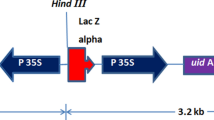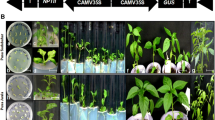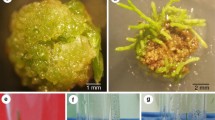Abstract
This paper describes the development of a reliable transformation system for garlic (Allium sativum L.) and its application in producing insect resistant GM garlic lines. The transformation system is based on Agrobacterium tumefaciens as a vector, using young callus derived from different callus sources: callus induced from both apical and non-apical root segments of in vitro plantlets, true garlic seeds and bulbils. Two different reporter genes were used in our garlic transformation experiments, namely the gusA gene coding for β-glucuronidase and the gfp gene coding for green fluorescent protein. A total of seven independent transformed callus lines derived from different callus sources were obtained. The advantage of the system developed is the short time period needed for completion of the protocol (about 6 months) and the year-round availability of high quality callus from in vitro roots. The highest transformation frequency in a single experiment (1.47%), was obtained using garlic cv. 'Printanor'. Differences existed between cultivars in transformation frequency but were not significant. The same was found for the plasmids used in transforming garlic. Via PCR the presence of the gusA, hpt (hygromycin phosphotransferase) and gfp genes could be demonstrated in putative transformed in vitro plants. Southern hybridization showed that the reporter gene gusA and the selective gene hpt were stably integrated into the garlic genome. After transfer to the greenhouse of in vitro regenerants, transgenic garlic harbouring the gusA gene survived and grew well, whereas the gfp transgenic garlic gradually died under these conditions.
Using this protocol transgenic garlic resistant to beet armyworm using the cry1Ca and H04 resistance genes from Bacillus thuringiensis were developed. Via Southern hybridization it was shown that the cry1Ca sequence was stably integrated into the garlic genome. After transfer of the transgenic in vitro garlic plants to the greenhouse, the cry1Ca plants developed normally and grew well to maturity with normal bulbs. However, all transgenic in vitro H04 garlic plants did not survive after transfer to the greenhouse. Transgenic cry1Ca garlic plants proved completely resistant to beet armyworm in a number of in vitro bio-assays. This finding will facilitate the development of new garlic cultivars resistant to beet armyworm.
Similar content being viewed by others
References
Barandiaran X., Pietro A.D. and Martin J. 1998. Biolistic transfer and expression of a uid A reporter gene in different tissues of Al-lium sativum L. Plant Cell. Rep. 17: 737-741.
Carozzi N.B., Rabe S.M., Miles P.J., Warren G.W. and De Haan P. T. 2002. Novel insecticidal toxins derived from Bacillus thur-ingiensis crystal proteins. International Application Published Under The Patent Cooperation Treaty WO 02/15701.
Chiu W.L., Niwa Y., Zeng W., Hirano T., Kobayashi H. and Sheen J. 1996. Engineered GFP as a vital reporter in plants. Current Biol. 6: 325-330.
De Cosa B., Moar W., Lee S.B., Miller M. and Daniell H. 2001. Overexpression of Bt cry2Aa2 operon in chloroplasts leads to formation of insecticidal crystals. Nature Biotechnology 19: 71-74.
De Maagd R.A., Kwa M.S.G., van der Klei H., Yamamoto T., Schipper B., Vlak J.M., Stiekema W. and Bosch D. 1996. Domain III substitution in Bacillus thuringiensis delta-endotoxin CryIA(b) results in superior toxicity for Spodoptera exigua and altered membrane protein recognition. Appl. Environ. Microbiol. 62: 1537-1543.
De Maagd R.A., Bosch D. and Stiekema W. 1999. Bacillus thur-ingiensis toxin-mediated insect resistance in plants. Trends in Plant Sci. 4: 9-13.
De Maagd R.A., Bravo A. and Crickmore N. 2001. How Bacillus thuringiensis has evolved specific toxins to colonize the insect world. Trends in Genet. 17: 193-199.
Eady C.C., Weld R.J. and Lister C.E. 2000. Agrobacterium tume-faciens-mediated transformation and transgenic-plant regenera-tion of onion (Allium cepa L.). Plant Cell Rep. 19: 376-381.
Eady C.C. 2002. Genetic transformation of onions.. In: Rabinowitch H.D. and Currah L. (eds), Allium Crop Science: Recent Advances. CAB International, Wallingford, UK, pp. 119-144.
Eady C.C., Davis S., Farrant J., Reader J. and Kenel F. 2003. Agrobacterium tumefaciens-mediated transformation and regen-eration of herbicide resistant onion (Allium cepa ) plants. Ann. Appl. Biol. 142: 213-217.
Ferrer E., Linares C. and Gonzalez J. M. 2000. Efficient transient expression of the beta-glucuronidase reporter gene in garlic (Al-lium sativum L.). Agronomie 20(8): 869-874.
Goh H.G., Park J.D., Choi Y.M., Choi K.M. and Park I.S. 1991. The host plants of beet armyworm, Spodoptera exigua (Hübner), (Lepidoptera: Noctuidae) and its occurrence. Korean J. Appl. Entomol. 30: 111-116.
Haque M.S., Wada T. and Hattori K. 1997. High frequency shoot regeneration and plantlet formation from root tip of garlic. Plant Cell, Tissue and Organ Cult. 50: 83-97.
Hood E.E., Helmer G.L., Fraley R.T. and Chilton M. D. 1986. The hypervirulence of Agrobacterium tumefaciens A281 is encoded in a region of pTiBo542 outside of T-DNA. J. Bact. 168: 1291-1301.
Hood E.E., Gelvin S.B., Melchers L.S. and Hoekema A. 1993. New Agrobacterium helper plasmids for gene transfer to plants. Transgenic Res. 2: 208-218.
Jefferson R.A. 1987. Assaying chimeric genes in plants; the GUS gene fusion system. Plant Mol. Biol. Rep. 5: 387-405.
Kik C. 2002. Exploitation of wild relatives for the breeding of cul-tivated Allium species.. In: Rabinowitch H.D. and Currah L. (eds), Allium Crop Science: Recent advances. CAB Interna-tional, Wallingford, UK, pp 81-100.
Kondo T., Hasegawa H. and Suzuki M. 2000. Transformation and regeneration of garlic (Allium sativum L.) by Agrobacterium-mediated gene transfer. Plant Cell Rep. 19: 989-993.
Lazo G.R., Stein P.A. and Ludwig R.A. 1991. A DNA transforma-tion-competent Arabidopsis genomic library in Agrobacterium. Bio/Technology 9: 963-967.
Mattanovich D., Rüker F., Machado A.D.C., Laimer M., Regner F., Steinkellner H., Himmler G. and Katinger H. 1989. Efficient transformation of Agrobacterium spp. by electroporation. Nucl. Acids Res. 17: 6747.
McCullagh P. and Nelder J.A. 1990. Generalized Linear Models. Chapman and Hall, London and New York.
Naimov S., Dukiandjiev S. and De Maagd R.A. 2003. A hybrid Bacillus thuringiensis delta-endotoxin gives resistance against a coleopteran and a lepidopteran pest in transgenic potato. Plant Biotechnology J. 1: 51-57.
Ohta S., Mita S., Hattori T. and Nakamura K. 1990. Construction and expression in tobacco of a beta-glucuronidase (GUS) reporter gene containing an intron within the coding sequence. Plant and Cell Physiol. 31: 805-813.
Outchkourov N.S., Peters J., De Jong J., Rademakers W. and Jongsma M.A. 2003. The promoter-terminator of chrysanthe-mum rbcS1 directs very high expression levels in plants. Planta 216: 1003-1012.
Park M.Y., Yi N.R., Lee H.Y., Kim S.T., Kim M., Park J.H., Kim J.K., Lee J.S., Cheong J.J. and Choi Y.D. 2002. Generation of chlorsulfuron-resistant transgenic garlic plants (Allium sativum L.) by particle bombardment. Mol. Breed. 9: 171-181.
Perlak F.J., Oppenhuizen M., Gustafson K., Voth R., Sivasupramaniam S., Heering D., Carey B., Ihrig R.A. and Roberts J.K. 2001. Development and commercial use of Bollgard R cotton in the USA: Early promises versus today's reality. Plant J. 27: 489-501.
Sallaud C., Meynard D., van Boxtel J., Gay C., Bès M., Brizard J.P., Larmande P., Ortega D., Raynal M., Portefaix M., Ouwerkerk P.B., Rueb S., Delseny M. and Guiderdoni E. 2003. Highly efficient production and characterization of T-DNA plants for rice (Oryza sativa L.) functional genomics. Theor. Appl. Genet. 106: 1396-1408.
Sawahel W.A. 2002. Stable genetic transformation of garlic plants using particle bombardment. Cell. Mol. Biol. Let. 7: 49-59.
Schnepf E., Crickmore N., van Rie J., Lereclus D., Baum J., Feitelson J., Zeigler D. R. and Dean D.H. 1998. Bacillus thuring-iensis and its pesticidal crystal proteins. Microbiol. Mol. Biol. Rev. 62: 775-806.
Schuler T.H., Poppy G.M., Kerry B.R. and Denholm I. 1998. Insect-resistant transgenic plants. Trends in Biotechnology 16: 168-175.
Shuto H., Abe T. and Sasahara T. 1993. In vitro propagation of plants from root apex-derived calli in Chinese chive (Allium tuberosum ROTTLER( and garlic (Allium sativum L.(. Japan. J. Breed. 43: 349-354.
Songstad D.D., Somers D.A. and Griesbach R.J. 1995. Advances in alternative DNA delivery techniques. Plant Cell Tissue Organ Cult. 40: 1-15.
Strizhov N., Keller M., Mathur J., Koncz K.Z., Bosch D., Prudovsky E., Schell J., Sneh B., Koncz C. and Zilberstein A. 1996. A synthetic cryIC gene, encoding a Bacillus thuringiensis delta-endotoxin, confers Spodoptera resistance in alfalfa and tobacco. PNAS (USA) 26: 15012-15017.
Tu J., Zhang G., Datta K., Xu C., He Y., Zhang Q., Khush G.S. and Datta S.K. 2000. Field performance of transgenic elite commercial hybrid rice expressing Bacillus thuringiensis delta-endotoxin. Nature Biotechnology 18: 1101-1104.
van Heusden A.W., van Ooijen J.W., Vrielink van Ginkel R., Verbeek W.H.J., Wietsma W.A. and Kik C. 2000. A genetic map of an interspecific cross in Allium based on amplified fragment length polymorphism (AFLP TM ) markers. Theor. App. Genet. 100: 118-126.
Wang M.B., Li Z.Y. and Matthews P. R. 1998. Improved vectors for Agrobacterium tumefaciens-mediated transformation of monocot plants. Acta Horticulturae 463: 401-407.
Zheng S.J., Henken B., Sofiari E., Jacobsen E., Krens F.A. and Kik C. 1998. Factors influencing induction, propagation and regeneration of mature zygotic embryo-derived callus from Allium cepa L.. Plant Cell Tissue Organ Cult. 53: 99-105.
Zheng S.J., Henken B., Sofiari E., Keizer P., Jacobsen E., Kik C. and Krens F. A. 1999. The effect of cytokinins and lines on plant regeneration from long-term callus and suspension cultures of Allium cepa L.. Euphytica 108: 83-90.
Zheng S.J., Henken B., Sofiari E., Jacobsen E., Krens F.A. and Kik C. 2000. Development of bio-assays and screening for resistance to beet armyworm (Spodoptera exigua Hübner) in Allium cepa L. and its wild relatives. Euphytica 114: 77-85.
Zheng S.J., Khrustaleva L., Henken B., Sofiari E., Jacobsen E., Kik C. and Krens F.A. 2001a. Agrobacterium tumefaciens-mediated transformation of Allium cepa L.: the production of transgenic onions and shallots. Mol. Breed. 7: 101-115.
Zheng S.J., Henken B., Sofiari E., Jacobsen E., Krens F.A. and Kik C. 2001b. Molecular characterization of transgenic shallots (Al-lium cepa L.) by adaptor ligation PCR (AL-PCR) and sequencing of genomic DNA flanking T-DNA borders. Transgenic Res. 10: 237-245.
Zheng S.J., Henken B., Krens F.A. and Kik C. 2003. The development of an efficient cultivar independent plant regeneration system from callus derived from both apical and non-apical root segments of garlic (Allium sativum L.). In Vitro Cell. Dev. Biol. Plant 39: 288-292.
Author information
Authors and Affiliations
Rights and permissions
About this article
Cite this article
Zheng, SJ., Henken, B., Kyun Ahn, Y. et al. The development of a reproducible Agrobacterium tumefaciens transformation system for garlic (Allium sativum L.) and the production of transgenic garlic resistant to beet armyworm (Spodoptera exigua Hübner). Molecular Breeding 14, 293–307 (2004). https://doi.org/10.1023/B:MOLB.0000047775.83715.b5
Issue Date:
DOI: https://doi.org/10.1023/B:MOLB.0000047775.83715.b5




